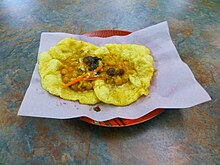Doubles (food)
 Doubles | |
| Place of origin | Trinidad and Tobago |
|---|---|
| Region or state | Caribbean, United States, Canada, United Kingdom |
| Created by | Emamool Deen |
| Serving temperature | Hot |
| Main ingredients | Curry chickpea and bara |
| Other information | Served with: various chutneys, kuchela, and pepper sauce |
Doubles is a common street food originating in Trinidad and Tobago. It consists of curried chickpeas served on two fried flatbreads. It is normally eaten during breakfast, but is also eaten occasionally during lunch or as a late night snack and popular hangover food.
Origins[edit]
Doubles as a dish was created in Princes Town by Emamool "Mamoodeen" Deen and his wife Raheman Rasulan Deen in 1936.[1] Deen used to sell curried chickpeas over single fried flatbread with chutneys. When his customers began requesting to double the bara in their orders the name “doubles” was coined.[2]
It has been speculated that it was inspired by a northern Indian dish called chole bhature (or sometimes channa bhatura).[3] Chole bhature is made by combining channa masala and bhature (poori), which is a fried bread made with maida flour, a common flour in Indian baking.
Preparation[edit]
As a base for the curry, onions, garlic and curry powder are fried briefly.[4] Boiled and drained chickpeas are added together with some water and spices, primarily cumin. The curry is cooked until the chickpeas are tender. A dough is prepared, shaped into flattened circles and briefly deep fried. Doubles can be served spicy, sweet, or savory. Condiments include spicy pepper sauce, kuchela, or green mango, culantro), cucumber, coconut, and tamarind chutneys.[5]
Cultural significance[edit]
Given the diversity of Trinidad, doubles is credited with its ability to "define and maintain symbolic boundaries of identification", and is considered an authentic standard of Trinidadian cuisine.[5] Doubles is a comfort food for displaced Trinidadians in major cities across the globe.[5] Its consumption has been credited with developing a "deep psychological imprinting" among them, and as such is considered culturally significant for how it encapsulated Trinidadian identity into a simple and unique snack.[5]
See also[edit]
References[edit]
- ^ Deen, Badru (2013). Out of the Doubles Kitchen: A Memoir of the First Family of Doubles. Palmetto Bay, Florida: Caritrade. p. 2. ISBN 978-0615855363.
- ^ Trinidadian Doubles are the Best Cheap Eats in Brooklyn — Dining on a Dime. Eater. 22 December 2015. Archived from the original on 21 December 2021. Retrieved 9 November 2019 – via Youtube.
- ^ Ganeshram, Ramin (28 February 2022). "Trinidad's addictive spicy street snack". BBC Travel. Retrieved 24 November 2023.
- ^ The Multi-Cultural Cuisine of Trinidad & Tobago. Naparima Girls' High School Cookbook. San Fernando: Naparima Girls' High School. 2002. p. 85. ISBN 976-8173-65-3.
- ^ a b c d Plaza, Dwaine (9 July 2014). "Roti and Doubles as Comfort Foods for the Trinidadian Diaspora in Canada, the United States, and Britain". Social Research: An International Quarterly. 81 (2): 463–488. doi:10.1353/sor.2014.0021. ISSN 1944-768X. S2CID 142287294.
